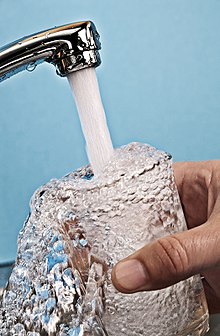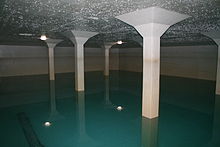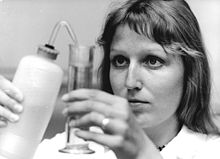Drinking water
Drinking water is water for human consumption. Drinking water is the most important foodstuff, it cannot be replaced (introductory and guiding principle of DIN 2000).
Drinking water is defined as any water that can be used for
- drinking, for cooking, for the preparation of food and drink
or in particular for the following domestic purposes:
- Personal care and cleaning,
- cleaning of objects that come into contact with foodstuffs (glasses, crockery, cutlery) or
- Cleaning of objects that are intended to come into contact with the human body on a more than temporary basis (clothing, linen).
Drinking water is fresh water with such a high degree of purity that it is classified - in accordance with the defined quality requirements - as suitable for human consumption, in particular for drinking and food preparation. Drinking water may only contain, or contain in certain quantities, substances or organisms for which either no limit values have been defined or for which defined limit values are not exceeded or fallen short of. For example, it must not contain pathogenic micro-organisms. Minerals should be contained in a minimum concentration. No limit values are specified for many chemical pollutants (see pollutant load). Under certain conditions (extraction site, pipe length), requirements for sterility at the extraction site (consumer) force permanent or need-based disinfection measures, which implies chemical contamination (e.g. through chlorination processes) within the above-mentioned limit values.
The quality requirements for drinking water in Germany are specified in DIN 2000, in the Drinking Water Ordinance (TrinkwV) and in the "General Ordinance for the Supply of Water" (AVBWasserV). The minerals most frequently dissolved in drinking water are the cations calcium (Ca2+), magnesium (Mg2+) and sodium (Na+) and the anions carbonate (CO32-), hydrogen carbonate (HCO3-), chloride (Cl-) and sulphate (SO42-). The sum of the concentrations of calcium and magnesium is called water hardness.
In seafaring, the drinking water carried is referred to as fresh water.
Water is not a scarce commodity in Germany. Unlike other natural resources, water is not consumed, but only used. It can become polluted in the process and is then possibly contaminated with pollutants. The total amount of water on earth in all aggregate states remains the same, only the distribution between the environmental compartments changes. Only an extremely small amount of water escapes as water vapour from the atmosphere into space.

Drinking water from the glass bottle

Drinking water from the tap
Water Requirement
Human water requirements vary according to physical condition, body mass, activity, ambient temperature, ambient humidity and other factors. Humans consume water in the form of beverages and food, and excrete it in urine, feces, sweat and breath. Water is produced in the body during the oxidative breakdown of organic food substances.
The WHO gives a drinking water requirement estimate of about two litres per day for a 60 kg adult and one litre for a child with a body weight of 10 kg for "high requirement". Recent studies indicate that fluid requirements can also be met by drinking sufficient amounts of juice, milk or coffee and vary greatly from individual to individual.
Tap water is also used for other purposes, such as washing clothes, flushing toilets, cleaning bodies, dishes and apartments. In recent decades, the consumption of drinking water was expected to be between 120 and 140 litres per day and per inhabitant. According to statistics published by the German Association of Energy and Water Industries (BDEW), the per capita consumption of drinking water in Germany has risen to between 120 and 140 litres per day. (BDEW), per capita consumption of drinking water in Germany has fallen continuously since 1990 as a result of the conscious use of water.
In other countries, consumption is sometimes much higher: consumption in Italy is stated at 260 litres per day and inhabitant; the desert city of Dubai consumed 500 litres per day and inhabitant around 2010 and is striving to reduce consumption in the production of drinking water there by desalinating seawater.

Queuing for water (March 1920 Kapp Putsch)
Drinking water quality
In Germany, Austria, Switzerland, France and the Netherlands, drinking water is the most intensively controlled foodstuff and is normally suitable for consumption without any restrictions.
Problems with the quality of drinking water from groundwater can usually be avoided by the proper designation of protected areas. In some cases, however, protection in areas with intensive conventional agricultural use is not sufficient. In particular, excessive slurry fertilisation or old sewage treatment plants and the resulting nitrate input into the groundwater can make the drinking water obtained from them dangerous for infants and young children. In these cases, the water supplier must reduce the nitrate concentration through treatment, deeper wells and cooperation with agriculture.
Water from bank filtrate may contain pollutants from sewage treatment plants or industrial discharges. Pollutants can enter water bodies during "normal operation" or through accidents. Water suppliers on Germany's major rivers have moved to apron control and the provision of redundant techniques for water treatment. Drugs and other pharmacologically active substances, for example X-ray contrast media or sex hormones, can enter drinking water through the water cycle and lead to systemic risks.
In German-speaking countries, drinking water has to meet higher quality standards than industrially packaged mineral water and table water. It is considered to be the best-studied foodstuff. Unlike natural mineral water, drinking water and table water does not have to be "originally pure", i.e. it may be treated and mixed. Thus, drinking water mixed with carbon dioxide - regardless of quality and mineral content - may not be offered as mineral water in restaurants.
In other countries, the quality of drinking water is often worse due to a lack of treatment and monitoring. In popular holiday destinations such as Spain and Portugal, the quality of tap water reportedly varies in some cases from "suitable for drinking" to "hazardous to health if consumed in large quantities". In China, 60 to 80 percent of the groundwater is heavily polluted and no longer suitable for drinking. In Europe, drinking water is generally suitable for cooking.
Pollution
In individual cases, increased contamination of drinking water with pollutants (for example arsenic, lead, cadmium, chloride, iron, copper, nitrate, phosphate, uranium, zinc) can occur at the end consumer. In March 2013, ZDF reported on increased contamination of drinking water with chemical waste such as antibiotics, pesticides or disinfectants. In eastern Switzerland, 300 drinking water and groundwater samples were taken, which showed that the official maximum level of the carcinogenic pesticide chlorothalonil was exceeded in over 10% of the samples. Medicinal substances were also found. Limits are set (in Germany) by the Drinking Water Ordinance, but for many pollutants there are no limits yet.
Lead
Old lead pipes in domestic installations can be responsible for elevated levels of lead in drinking water. In the evaluation of 20,000 drinking water analyses from the period 1994 to 2004, from taps in households, Stiftung Warentest found more than 25 micrograms per litre (µg/l) of lead in five percent of the samples. According to the study, there was an increased risk in eastern German regions, in Schleswig-Holstein and in the greater Hamburg, Bremen, Bonn and Frankfurt areas. The limit value according to TrinkwV is 10 µg/l. Drinking water analyses can clarify whether one's own domestic installation is affected.
As of 2021, up to 20 million people in the U.S. are supplied with water from lead pipes.
Arsenic and fluoride
Around 300 million people worldwide obtain their water from groundwater supplies. However, around 10 per cent of groundwater wells are contaminated with arsenic or fluoride. These trace substances are mostly of natural origin and are washed out by water from rocks and sediments. In 2008, the Swiss Federal Institute of Aquatic Science and Technology (Eawag) presented a new method for the production of hazard maps for geogenic toxicants in groundwater, without the need to examine all the wells and groundwater supplies in a region.
In 2016, Eawag made its knowledge freely available on the Groundwater Assessment Platform (GAP). This Internet portal enables members of the authorities, NGO staff and other experts to upload their own measurement data and produce risk maps for areas of their choice.
Uranium exposure
Germany
In 2008, the consumer organisation Foodwatch warned of high uranium concentrations, with 39 µg/l uranium detected in Maroldsweisach in the district of Hassberge (Bavaria), 33 µg/l in Lobenrot in the district of Esslingen and 30.08 µg/l in Reimershagen in the district of Rostock (Mecklenburg-Western Pomerania). A total of 8200 reported measurements show 150 above 10 µg/l, the limit value of the amended Drinking Water Ordinance of 2011. On average, drinking water in Germany contains less uranium (0.3 µg/l) than mineral water (2.8 µg/l). The connection between elevated uranium levels in mineral and drinking waters and the geology of the groundwater reservoir rocks was investigated nationwide for the first time in 2008. It was found that elevated uranium levels are linked to formations such as red sandstone or Keuper, which themselves have elevated uranium levels geogenically. Locally, uranium from phosphate fertilizers has leached into the groundwater.
Switzerland
As part of a monitoring programme by the Federal Office of Public Health (FOPH) in the 2000s, the uranium content of drinking water was investigated on the basis of 5000 samples in Switzerland. The results were scientifically analysed. It was found that higher concentrations were found above all in the Alpine region if the water was obtained from groundwater or spring water "in contact with uranium-bearing rocks and sediments." In 0.3% of the samples, the WHO guideline value of 30 µg/l was exceeded. Based on the test results, the FOPH intends to stipulate the limit value of 30 µg/l in the Ordinance on Foreign Substances and Ingredients, which would mean that "affected municipalities would have to remediate their water supplies within a transitional period of 5 years."
Biological stresses
Drinking water can in individual cases be the source of epidemic disease outbreaks caused by enteric pathogenic viruses. In Finland, for example, a study of drinking water-related norovirus outbreaks was carried out between 1998 and 2003. In 10 of 18 Norwalk virus outbreaks, the detected subtypes were found in the stool samples of the patients as in the corresponding drinking water samples. These are exceptions, which occur regionally in a very limited manner and which are immediately eliminated by remediation. According to the Federal Health Office and the Federal Environment Agency, well over 99 % of the drinking water supplied in Germany is free of objections.

Schlund water reservoir in Zollikon, filled with treated lake water from Lake Zurich

Control of drinking water
Questions and Answers
Q: What is drinking water?
A: Drinking water is water that is safe to drink or use for food preparation.
Q: What do rivers, streams, lakes, and underground contain?
A: Rivers, streams, lakes, and underground may contain organisms that cause disease and chemicals that might cause illness.
Q: What is water treatment?
A: Water treatment involves filtering the water through sand beds and then adding a chemical to kill any remaining organisms.
Q: How much drinking water is needed for good health?
A: The amount of drinking water needed for good health varies. Americans, on average, drink one liter of water per day, and 95% drink less than three liters per day. For those who work in a hot climate, up to 16 liters a day may be required.
Q: What are the other uses of water besides drinking?
A: Other uses of water include washing, toilets, and irrigation.
Q: Is greywater safe to use for toilets or irrigation?
A: Greywater (wastewater) may be used for toilets or irrigation, but using greywater for irrigation may have risks.
Q: What makes water unacceptable?
A: Water may be unacceptable if it has high levels of toxins or suspended solids.
Search within the encyclopedia